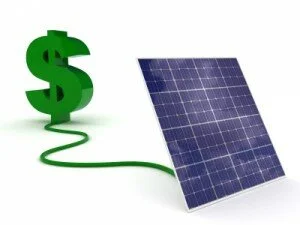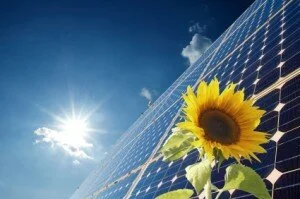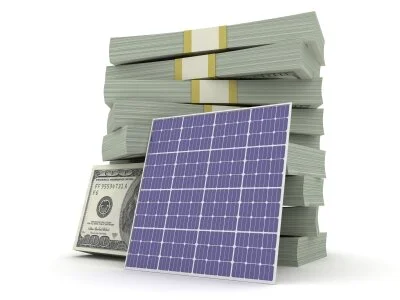[This post is part of a series about our net-zero residential solar project – see a list of links to the full series here, a list of frequently asked questions here or click here to bring up all Green-related posts. Next Post in Series / Previous Post in Series.]
Once you have a basic equipment list, you can take a more detailed look at the costs and financing alternatives. As discussed in the posts on state incentives and federal incentives, there are a number of programs in place to ease the cost burden of paying for all this exotic and expensive equipment. And there are a number of different ways you can go about paying for it.
Below is a diagram outlining the basic decisions, courtesy of our installer Independent Power Systems.
On the diagram you will see that the four key moving parts are (i) state rebates, (ii) tax credits, (iii) energy bill savings and (iv) SREC income.
The owner of record of the system is entitled to the rebates and tax credits, and the homeowner is entitled to the SREC income and energy bill savings. If you purchase the system outright, you get all four. If you lease it on a prepaid basis, you get the SREC income and the energy bill savings. If you lease it over time, you get a portion of the energy savings and nothing else, but you have no up-front costs, so those savings are essentially money directly into your pocket from day one.
As noted in the post on federal incentives, when I personally walked through this decision tree, I felt the pre-paid lease was the most attractive option. Although the zero-money-down option still has great environmental benefits and some cost savings to recommend it, I shied away from it for a couple of reasons: I didn’t like the idea of giving a big chunk of my energy savings to the manufacturer (in order to help cover interest expense for using their money to buy the system), and I really didn’t want the obligation of either pulling the system down at year 20 or paying a high residual to buy the system.
In comparison, the prepaid lease was the best of all worlds: it brings the cost of the system way down by allocating the depreciation and federal tax incentives to the manufacturer to defray some of the purchase price, it avoids the interest expense you would pay with a typical lease paid over time, and it allows you to buy the system out for a very very low residual at year seven (after the manufacturer has exhausted the tax benefits to be gained by being the owner of record for seven years).
And you can still finance a prepaid lease – you just provide your own financing; you should be able to use an existing tax-deductible home equity line if you have one, or arrange for one of the many solar finance products offered by retail banks.
 With the prepaid lease as my preferred option, how do the economics of our project shake out? Well, we’ll pay a relatively stiff price up front (think about buying an averaged priced car to give you a ballpark), but based on the calculations we worked through with IPS, we expect to recoup that up-front cost in less than 5 years. This is based on a combination of electricity savings and SREC income. Once the upfront system cost has been recouped, then the fun begins: the system goes on to generate SREC income of approximately $550 a month for at least the balance of ten years (the minimum number of years guaranteed by the statute, but could be longer if they don’t alter or cancel the program), and it will generate 100% power bill savings for the reminder of its useful life of as much as 30-35 years.
With the prepaid lease as my preferred option, how do the economics of our project shake out? Well, we’ll pay a relatively stiff price up front (think about buying an averaged priced car to give you a ballpark), but based on the calculations we worked through with IPS, we expect to recoup that up-front cost in less than 5 years. This is based on a combination of electricity savings and SREC income. Once the upfront system cost has been recouped, then the fun begins: the system goes on to generate SREC income of approximately $550 a month for at least the balance of ten years (the minimum number of years guaranteed by the statute, but could be longer if they don’t alter or cancel the program), and it will generate 100% power bill savings for the reminder of its useful life of as much as 30-35 years.
So in rough terms, once you have paid it off, what kind of numbers does it go on to generate? If you assume SRECs will be worth say, $500 each (a conservative guess), and with the cost of power going up over time, your average power bill would have been $200 (also a conservative guess), you are looking at five years of SREC income equal to $30,000 plus 25 years of power savings equal to $60,000, or about $90,000 in economic value over the life of the system, above and beyond repayment of the original expense of the system. It might even be a little more if the cost of electricity goes up as most expect it to (or it could be a little less if the cost of electricity stays the same and SREC prices go down a little bit.) So if you put your own cash into the upfront lease payment, you are looking at something like at least a 3X cash-on-cash return. And if you use debt for half of that amount, you are looking at closer to a 6X cash-on-cash return on your money invested. And these are guesses based on conservative numbers. But regardless of the exact numbers, you are talking about one heck of a return on some funds that were only tied up for 4-5 years.

And what about the environment? Well, our system is guaranteed to produce between 11,642-12,868 kWh of solar energy per year. If you translate that into gasoline terms, that is equivalent to 278,045 lbs. of CO2 saved. How much CO2 is that? It is the equivalent of driving an average car 333,645 miles. That same number of miles driven would also produce 312 lbs of NOx emissions. If you wanted to absorb that much CO2 it would require 3,233 mature trees. And if you think of it in terms of solid waste, it is the equivalent of recycling 92,682 lbs of solid waste or avoiding 41,887 lbs of greenouse gas from land-filled garbage. (Source: SunPower Corp. figures).
This post is part of a series about our net-zero residential solar project – see a list of links to the full series here, a list of frequently asked questions here or click here to bring up all Green-related posts. Next Post in Series / Previous Post in Series.
Subscribe – To get an automatic feed of all future posts subscribe to the RSS feed here, or to receive them via email enter your address in the box in the upper right-hand corner of this page or go here and enter your email address in the box in the upper right. You can also follow me on Twitter @cmirabile and on Google+.

Speak Your Mind